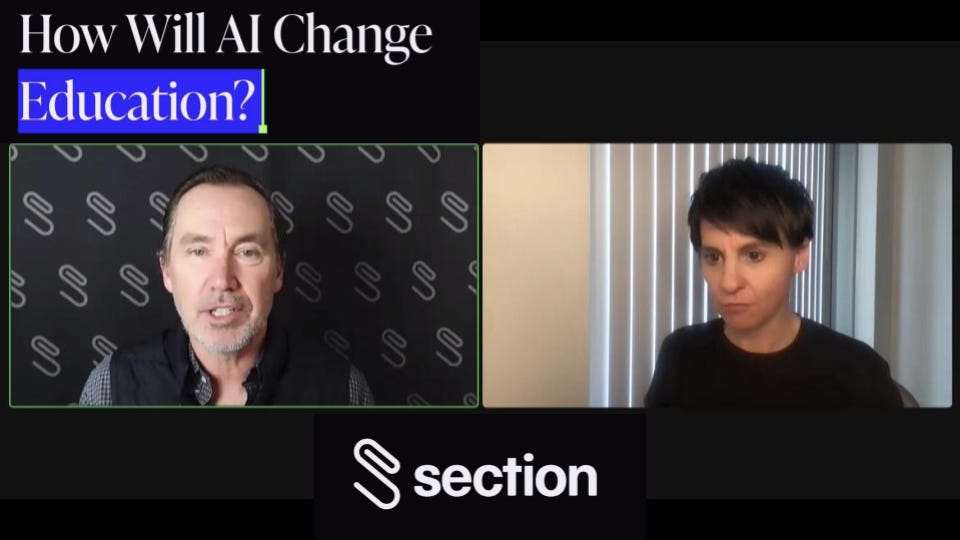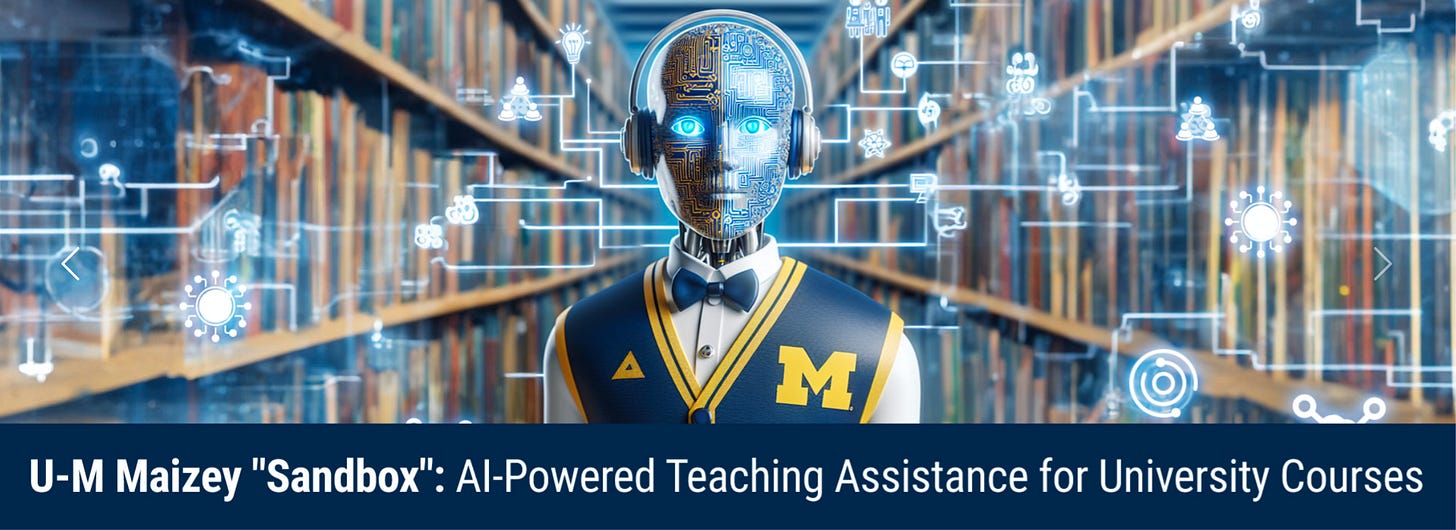Synthetic Video & AI Professors
Are we witnessing the emergence of a new, post-AI model of async online learning?
Hey folks!
This week, I was lucky enough to join Greg Shove, CEO of Section School for a 1hr fireside chat about the impact of AI on Education.
One of the big questions to emerge from the conversation was: what does async online learning look like in a post-AI world?
What we’re really asking here is, can AI help to fix broken model of async online learning which has consistently failed to deliver on its promise to make high quality, high impact education available at scale?
The Problem With Online Async Learning
First of all, what’s the problem with online async learning? The answer here is two fold:
Lack of relevance: in part to deliver on their target of access and reach, online async courses tend to offer a “one size fits all” learning experience. We know from decades of research that a key part of the learning formula - particularly learner motivation - lies in a sense relevance and meaning: a feeling that this learning experience is designed for me and has immediate, real-world value By aiming to please everyone, traditional sync online learning fails to meet the learning needs of anyone.
Lack of presence: we know from decades of research that another key part of the learning formula is teacher presence - i.e. a sense of connection with a teacher/expert/coach who provides both academic and “pastoral” support. The quantity and quality of teacher presence is directly correlated to learner motivation, persistence and achievement. While some innovative approaches like Coursera’s Guided Projects & Blended MOOCs have attempted to scale teacher/coach presence, a lack of tailored, responsive “always on” support in online async courses has played a major part in their lack of stickiness and impact.
The TLDR here is that until now, we have had to choose between effectiveness or reach. If we measure the success of online async courses by reach and access metrics, online async courses have been a huge success. If we measure their success by impact on learners, they have failed (an continue to fail) dramatically.
So, how might AI change this?
The Impact of AI on Online Async Learning
While you could be forgiven for thinking that the conversation about AI and Education is only a couple of years old, researchers have been exploring for decades if and how AI might impact education in general and async, online learning in particular.
Here’s what we learned:
AI for Relevance
Multiple research studies have show that both learner retention and achievement improve when AI-driven models are used to predict and recommend learning materials, activities and assessments based on individual students' needs.
AI-driven systems have also proved capable of tracking, predicting and “correcting” (through the creation of more relevant materials) using machine learning algorithms. In these studies, AI systems not only predicted learner engagement but also actively helped to increase it.
TLDR: by effectively tailoring the learning experience to the learner's comprehension levels and preferred learning modes, AI can enhance the overall learning experience, leading to increased “stickiness” and higher rates of performance in assessments.
To learn more, check out the research summaries and findings in recent research by Ayouni et al., 2021, Murtaza et al., 2022 & Pardamean et al., 2022.
AI for Presence
Research into so-called “Intelligent Tutoring Systems” (more commonly known as AI tutors) has been thriving since the 1970s.
The first Intelligent Tutoring System (ITS), known as the SCHOLAR system, was launched in back in 1970 and - rather than just providing pre-programmed responses like we continue to see in a lot of online quizzes - was capable of back-and-forth dialogue with students.
More recently, experiments like the creation of Jill Watson, an AI-powered teaching assistant, at Georgia Tech (2016) have helped us to understand in more detail how AI might impact our ability to scale not just learning content but also learning support.
So far, research has found that:
AI tutors can facilitate both improved communication and an increased send of support among learners. For example, by providing just-in-time, personalised interactions AI tutors have have been positively acknowledged for enhancing the quality of learner-instructor relationships (
AI-driven platforms can also enhance the feedback and grading processes, making asynchronous discussions more impactful and less time-consuming for educators. For instance, AI has been shown to positively affect the workflow of both grading and feedback, impacting educators' perceptions positively and enhancing their ability to provide a high quantity of quality feedback.
TLDR: AI enables us to scale responsive, personalised “always on” feedback and support in a way that might help to solve one of the most wicked problems of online async learning - isolation and, as a result, disengagement.
To learn more, check out the research summaries and findings in a recent literature review by Rizvi, 2023.
The Rise of AI-Powered Online Async Learning
Since the launch of GPT 3.5 at the end of 2022, we have seen patterns of conversation, research and experiments which suggest that we are entering a new phase of post-AI online async learning.
This new model leverages the power of machine learning and generative AI to start to solve the two most wicked problems of traditional online async learning:
Augmented Relevance
While developing fully autonomous and responsive learning pathways is still on the horizon, more and more online learning providers are using the power of generative AI to increase the relevance and value of learning content.
Using synthetic video AI tools like Synthesia, Colossyan & HeyGen, they are able to create learning experiences which, as Greg put it, “go deep into a niche” and provide “one size fits a niche” rather than “one size fits all [no one]” experiences.
Greater relevance is also delivered thanks to AI-powered translation tools like SmartCat which enable educators to create more content in more languages than ever before.
Augmented Presence
In the last year we have also seen the rise of an unprecedented number of “always on” AI tutors, built to provide coaching and feedback how and when learners need it.
Perhaps the most well-known example is Khan Academy’s Khanmigo and its GPT sidekick Tutor Me. We’re also seeing similar tools emerge in K12 and Higher Ed where AI is being used to extend the support and feedback provided for students beyond the physical classroom.
We’re also seeing the rise of a new generation of AI-enhanced MOOCs, which deliver responsive and “always on” student support via “Prof Bots”.
Concluding Thoughts: Human-Machine Interaction
The hypothesis of all of the organisations cited here is that AI is a tool that empowers us - finally - to deliver on a long held vision to make effective education available at scale. Will this prove to be the case? Only time will tell.
One thing I’m sure of is that the answer will depend as much on the emotions of humans as it will on the effectiveness of AI technology. Even if AI is capable of building deeply personalised, highly-supported learning experiences, how will the absence of “real” humans impact the process of teaching and learning?
This is the biggest and most important question of them all.
Happy innovating,
Phil 👋
Happy innovating!
Phil
PS: If you want to be part of a thriving community of AI + learning design folks, join us on LinkedIn.
PPS: If want to dive into the world of AI & education with me and a community of innovators from the world of education, check out my 3 week online bootcamp.
PPPS: If want to get access to a monthly digest of the most important research and experimentation in the world of AI & education, check out my Learning Futures Digest.






